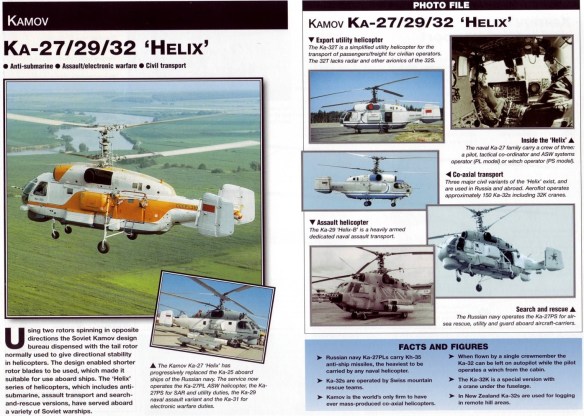Country of origin: Russia
Type: Assault transport & radar picket helicopter
Powerplants: Ka-29 – Two 1635kW (2190shp) Klimov (Isotov) TV3-117V turboshafts, driving two three bladed counter rotating coaxial main rotors.
Performance: Ka-29 – Max level speed at sea level 280km/h (151 kt), cruising speed 235km/h (127kt). Max initial rate of climb 3050ft/min.
Service ceiling 14,100ft.
Hovering ceiling out of ground effect 12,140ft.
Ferry range 740km (400nm), range with max standard fuel 460km (248nm). Combat radius with six to eight attack passes 100km (54nm).
Weights: Ka-29 – Empty 5520kg (12,170lb), max takeoff 12,600kg (27,775lb).
Dimensions: Ka-29 – Main rotor diameter (each) 15.90m (52ft 2in), length overall excluding nose probes and rotors 11.30m (37ft 1in), height to top of rotor hub 5.40m (17ft 9in). Main rotor disc area each 198.5m2 (2138sq ft).
Accommodation: Crew of two. Main cabin can accommodate up to 16 combat equipped troops, or four stretcher patients and six seated patients in medevac configuration.
Armament: One 7.62mm four barrel Gatling machine gun mounted underneath right side door. Two pylons on each stub wing can carry rocket pods, or two four round clusters of 9M114 Shturm (AT-6 Spiral) ASMs and two rocket pods. Can carry a 30mm gun above left side stub wing.
Operators: Russia
History: The Ka-29 development of the Ka-27 was designed specifically for use providing fire support of Russian Navy amphibious landing operations. The Ka-29 ‘Helix-B’ was initially thought to be a non-radar equipped transport version of the Ka-27, although this observation has since been proven to be untrue. The basic Ka-29 variant is the Ka-29TB attack helicopter, of which around 30 are thought to have entered Russian Navy service. Service entry was in 1985. While the Ka-29 is based on the Ka-27, there are a number of substantial changes. The Ka-29’s forward fuselage is widened, with changes to the nose profile including a five piece flat windscreen and bluntened nose. Armament is carried on two stub wings with two hardpoints each, typically carrying rocket pods or air-to-surface missiles. The Ka-29 also features a small radar thought to be for missile targeting, and an electro optical sensor under the nose, thought to be a combined TV/FUR unit. The Ka-29RLD is a radar picket development of the Ka-29 and features a large rotating radar mounted beneath the fuselage. The radar folds flat against the fuselage bottom for transit flight and stowage, and extends and rotates beneath the fuselage when operated. As on other Kamov helicopters, the undercarriage retracts upwards, so it doesn’t interfere with the radar. The Ka-29RLD was first observed in 1988 when two were observed operating off the carrier Admiral of the Fleet Kuznetsov, although its present status is unclear.
